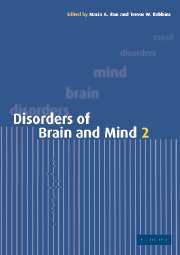Book contents
- Frontmatter
- Contents
- List of contributors
- Preface
- Part I Genes and behaviour
- Part II Brain development
- Part III New ways of imaging the brain
- 5 New directions in structural imaging
- 6 The application of neuropathologically sensitive MRI techniques to the study of psychosis
- Part VI Imaging the normal and abnormal mind
- Part V Consciousness and will
- Part IV Recent advances in dementia
- Part VII Affective illness
- Part VIII Aggression
- Part IX Drug use and abuse
- Index
- Plate section
- References
5 - New directions in structural imaging
from Part III - New ways of imaging the brain
Published online by Cambridge University Press: 19 January 2010
- Frontmatter
- Contents
- List of contributors
- Preface
- Part I Genes and behaviour
- Part II Brain development
- Part III New ways of imaging the brain
- 5 New directions in structural imaging
- 6 The application of neuropathologically sensitive MRI techniques to the study of psychosis
- Part VI Imaging the normal and abnormal mind
- Part V Consciousness and will
- Part IV Recent advances in dementia
- Part VII Affective illness
- Part VIII Aggression
- Part IX Drug use and abuse
- Index
- Plate section
- References
Summary
Introduction
Foucault commented that ‘the medical gaze … contains within a single structure, different sensorial fields. The ‘glance’ has become a complex organisation with a view to the spatial assignment of the invisible’ (Foucault 1963). During the last two decades, the structural brain image has been deconstructed using an increasing variety of analytic techniques in order to reveal previously invisible pathology.
Since the first major psychiatric computed tomography (CT) study published in 1976 (Johnstone et al. 1976), structural imaging has been utilized to investigate the major psychiatric disorders. It has become clear that many of these disorders are characterized by subtle structural brain changes. However, brain structure shows considerable variability between individuals, in terms of size, shape and composition (e.g. relative grey and white matter). Thus, the detection of a small neuropathological signal in the presence of loud noise (from neurodevelopment and other sources) has been a central problem for structural imaging studies and has provided the impetus for the development of a range of new analytic approaches. Several psychiatric and neurological disorders have been particularly important in terms of the development of structural imaging techniques, including schizophrenia, multiple sclerosis and epilepsy. In this chapter we illustrate new directions in structural imaging using research into brain changes in schizophrenia.
In addition to identifying the contributions of these new techniques, we highlight some of the problems that we believe have retarded progress in structural imaging.
Information
- Type
- Chapter
- Information
- Disorders of Brain and Mind , pp. 95 - 127Publisher: Cambridge University PressPrint publication year: 2003
References
Accessibility standard: Unknown
Why this information is here
This section outlines the accessibility features of this content - including support for screen readers, full keyboard navigation and high-contrast display options. This may not be relevant for you.Accessibility Information
- 2
- Cited by
